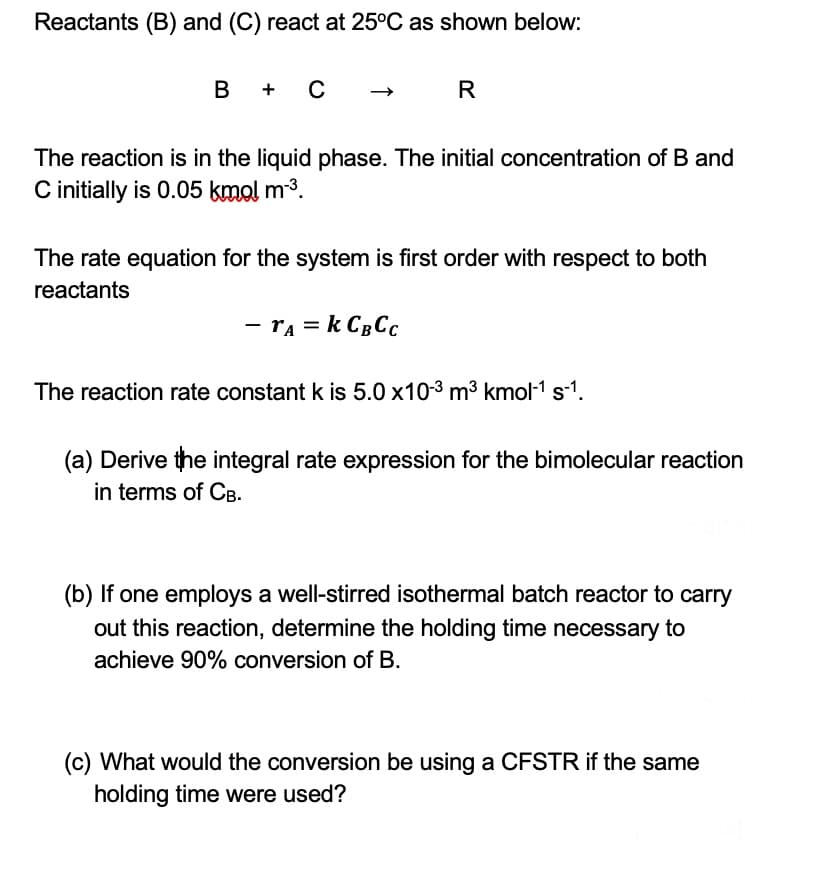Reactants (B) and (C) react at 25°C as shown below: B + C R The reaction is in the liquid phase. The initial concentration of B and C initially is 0.05 kmol m-³. The rate equation for the system is first order with respect to both reactants — - ra = k CgCc The reaction rate constant k is 5.0 x10-³ m³ kmol-¹ s-¹. (a) Derive the integral rate expression for the bimolecular reaction in terms of CB. (b) If one employs a well-stirred isothermal batch reactor to carry out this reaction, determine the holding time necessary to achieve 90% conversion of B. (c) What would the conversion be using a CFSTR if the same holding time were used?
Reactants (B) and (C) react at 25°C as shown below: B + C R The reaction is in the liquid phase. The initial concentration of B and C initially is 0.05 kmol m-³. The rate equation for the system is first order with respect to both reactants — - ra = k CgCc The reaction rate constant k is 5.0 x10-³ m³ kmol-¹ s-¹. (a) Derive the integral rate expression for the bimolecular reaction in terms of CB. (b) If one employs a well-stirred isothermal batch reactor to carry out this reaction, determine the holding time necessary to achieve 90% conversion of B. (c) What would the conversion be using a CFSTR if the same holding time were used?
Introduction to Chemical Engineering Thermodynamics
8th Edition
ISBN:9781259696527
Author:J.M. Smith Termodinamica en ingenieria quimica, Hendrick C Van Ness, Michael Abbott, Mark Swihart
Publisher:J.M. Smith Termodinamica en ingenieria quimica, Hendrick C Van Ness, Michael Abbott, Mark Swihart
Chapter1: Introduction
Section: Chapter Questions
Problem 1.1P
Related questions
Question

Transcribed Image Text:Reactants (B) and (C) react at 25°C as shown below:
B + C
R
The reaction is in the liquid phase. The initial concentration of B and
C initially is 0.05 kmol m-³.
The rate equation for the system is first order with respect to both
reactants
– ra = k CgCc
The reaction rate constant k is 5.0 x10-³ m³ kmol-¹ s-1.
(a) Derive the integral rate expression for the bimolecular reaction
in terms of CB.
(b) If one employs a well-stirred isothermal batch reactor to carry
out this reaction, determine the holding time necessary to
achieve 90% conversion of B.
(c) What would the conversion be using a CFSTR if the same
holding time were used?
Expert Solution
This question has been solved!
Explore an expertly crafted, step-by-step solution for a thorough understanding of key concepts.
This is a popular solution!
Trending now
This is a popular solution!
Step by step
Solved in 4 steps

Recommended textbooks for you

Introduction to Chemical Engineering Thermodynami…
Chemical Engineering
ISBN:
9781259696527
Author:
J.M. Smith Termodinamica en ingenieria quimica, Hendrick C Van Ness, Michael Abbott, Mark Swihart
Publisher:
McGraw-Hill Education

Elementary Principles of Chemical Processes, Bind…
Chemical Engineering
ISBN:
9781118431221
Author:
Richard M. Felder, Ronald W. Rousseau, Lisa G. Bullard
Publisher:
WILEY

Elements of Chemical Reaction Engineering (5th Ed…
Chemical Engineering
ISBN:
9780133887518
Author:
H. Scott Fogler
Publisher:
Prentice Hall

Introduction to Chemical Engineering Thermodynami…
Chemical Engineering
ISBN:
9781259696527
Author:
J.M. Smith Termodinamica en ingenieria quimica, Hendrick C Van Ness, Michael Abbott, Mark Swihart
Publisher:
McGraw-Hill Education

Elementary Principles of Chemical Processes, Bind…
Chemical Engineering
ISBN:
9781118431221
Author:
Richard M. Felder, Ronald W. Rousseau, Lisa G. Bullard
Publisher:
WILEY

Elements of Chemical Reaction Engineering (5th Ed…
Chemical Engineering
ISBN:
9780133887518
Author:
H. Scott Fogler
Publisher:
Prentice Hall


Industrial Plastics: Theory and Applications
Chemical Engineering
ISBN:
9781285061238
Author:
Lokensgard, Erik
Publisher:
Delmar Cengage Learning

Unit Operations of Chemical Engineering
Chemical Engineering
ISBN:
9780072848236
Author:
Warren McCabe, Julian C. Smith, Peter Harriott
Publisher:
McGraw-Hill Companies, The